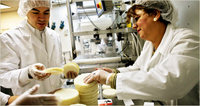Immigrant entrepreneurs and the American economy
n

nn
As the flow of immigrants to suburban and small-town Americanoutpaces the growth of bustling ethnic centers in New York, manynforeign-born entrepreneurs… are facing an unfamiliarncrossroads. In the city, rising rents and density hamper growth, whilenswelling ethnic enclaves in the suburbs generate competitors. Yet innother places, opportunity beckons as never before, as immigrants expandnthe tastes of mainstream America.
nn
Whether these businessesnexploit the new chances to break out or succumb to the new perils, thencity’s economy will feel the effects. “Immigrants have been thenentrepreneurial spark plugs of cities from New York to Los Angeles,”nsaid Jonathan Bowles, the director of the Center for an Urban Future, anprivate, nonprofit research organization that has studied the dynamicsnof immigrant businesses that turned decaying neighborhoods into vibrantncommercial hubs in recent decades. “These are precious and importantneconomic generators for New York City, and there’s a risk that we mightnlose them over the next decade.”
nnnnnnnn
What’s amazing is that the city doesn’t do more to encourage these businesses. As the article points out, these businesses tend to get caught up with language barriers, bureaucratic nightmares, and credit problems.
nn
Which sounds a lot like the state of innovation in many companies today. The people doing the innovating on the “edges” of the corporation are needlessly bogged down with bureaucratic nightmares and hoops to jump through. Yet, it is exactly this type of raw innovation that needs to be nurtured, protected and given an outlet to grow.
nn
[image: Immigrant Entrepreneurs]
n




